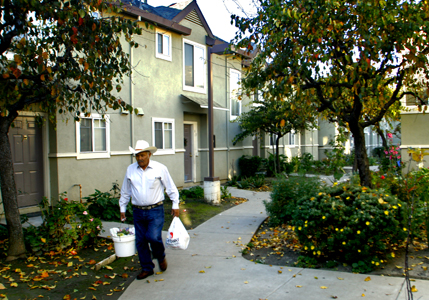
Planning commission weighs options for inexpensive homes
As the cost of living increases in San Benito County and wages
stagnate, more residents are struggling to find affordable
housing.
A quarter of all income earners in San Benito County are ranked
as very low or extremely low income, earning less than $33,000 for
a family of four, according to the 2003 Income Limits.
Planning commission weighs options for inexpensive homes
As the cost of living increases in San Benito County and wages stagnate, more residents are struggling to find affordable housing.
A quarter of all income earners in San Benito County are ranked as very low or extremely low income, earning less than $33,000 for a family of four, according to the 2003 Income Limits.
At least one planning commissioner is asking what happened to affordable housing.
Seventy percent of low-income households are spending more than 30 percent of their income on housing costs and are considered to be overpaying for their housing, according to the housing element of the 2005 General Plan for Hollister.
One of the key findings of the housing element is that roughly 80 percent of all the homes in Hollister are single-family detached homes, leaving fewer choices for affordable housing.
More families than single people live in Hollister, according to Planning Commissioner David Huboi. Of the families that live here, there are a higher percentage of families living with more than two people to one room, according to Huboi.
There have been low-income projects in the past and some of them have been successful. But there was also a time when the attitude was to push Section Eight and low-income housing off to the side, out of sight and to try and hide it away from the rest of the population, Huboi said. Now, Hollister is trying to infill areas with all types of housing so that one income level is not singled out and isolated.
Nationally, many housing projects in urban areas, such as San Francisco, Los Angeles and Detroit have been known for high crime levels and drug abuse. Visitacion Valley on San Francisco’s southeast side is one of these housing projects, notorious for violent crimes. In 2005 the housing project had 16 fatal shootings.
Huboi has seen some of those negative elements. He has worked on rehabilitation of housing projects in Santa Clara and San Jose as well as locally.
“When you try and sequester projects they don’t work because they need to be incorporated into the community,” Huboi said. “Once you’ve built an environment and it starts to decay – yes it does attract crimes – but that only happens when you don’t have pride in ownership.”
One of the ways to attract pride of ownership is through projects such as sweat-equity housing. Families help to build their own house and the work they do on the house is used as the down payment for that home.
Eugenia Sanchez, Council member for District 2 in Hollister, owns a sweat-equity house and understands the opportunity this type of housing can provides for the residents of Hollister.
“This gave us the opportunity to own our own home,” Sanchez said. “My father also owns a sweat-equity house and it’s one of the reasons my family came to Hollister to begin with. These types of projects give families the opportunity to own their own homes.”
Huboi agreed.
“Sweat-equity projects work because they present a sense of ownership,” Huboi said. “People care more about their homes and their neighborhoods because they have invested in making them what those homes are.”
The price of homes in Hollister is increasing every year and there is a need for more homes for low-to medium-income families, but Sanchez is not certain what the answer is. She is not yet familiar enough with the general plan and the housing element.
One of the things Huboi is pushing for as an architect and a planning commissioner is the development of more projects that combine housing for different incomes.
“Design is the key concept. If it’s done well, low-income can add to the community. And good income mixes can add to a development,” Huboi said.
Higher density developments are the only way people are going to be able to afford their first homes, Huboi said. One way planning commissioners are looking at increasing affordable housing is through condo developments. The planning commission is currently looking at projects where apartment complex owners would like to convert into condos. Duplexes are another higher-density development that would be a way to offer more affordable housing.
Sweat equity can work for apartments, too, according to Huboi. Anything that brings people together and gives residents a sense of ownership can generate the sense of security.
There are lots of myths out there about low-income housing, according to Huboi. Developers are fearful that housing projects won’t conform to pre-existing neighborhood designs, but there are a lot of neighborhoods out there that debunk those myths.
Los Arroyos in Gilroy is one such neighborhood. It is a 373-unit development that contains 40 percent market-rate houses and 60 percent below market rate houses.
South County Housing designed the project and has been developing mixed-income projects in Silicon Valley and the Central Coast for more than 15 years. Much of their focus has been in Gilroy, Morgan Hill and Hollister.
They completed their first development in Morgan Hill during the early 1990s, according to South County Housing Executive Director Dennis Lalor.
“I can clearly say that mixed-income developments can be a positive tool to achieving goals,” Lalor said. “The key things that they do is provide more choice and offer an opportunity for a broader range of people within a community.”
Projects such as these promote diversity.
“Separating communities is not good at large,” Lalor said. “If you go back forty or fifty years, it was very common to have people from different income levels all in the same neighborhood. It was not bad then and we don’t think it’s bad now.”
He reaffirmed Huboi’s thoughts about mixed-income housing.
“Now is the time we have to set the table for affordable housing,” Huboi said. “Because of the moratorium we’re limited with what we can do now, but we have to make room for this type of development.”
Patrick O’Donnell can be reached at po*******@**********ws.com.









